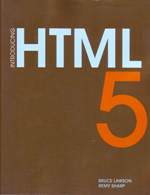 This is a particularly timely book for me.
This is a particularly timely book for me.
It’s quite a different kettle of code to Jeremy Keith’s HTML5 for Web Designers. That book explained how I could confidently starting using HTML5 with my existing and planned web projects.
This book, Introducing HTML5 by Bruce Lawson and Remy Sharp, goes into much greater detail about how much more I can do with HTML5.
Bruce Lawson is a UK web developer who works for Opera, with an impressive understanding of, and commitment to, the open web, standards and accessibility. Bruce is coming to Australia in November to hold a series of workshops on ARIA-HTML5 for WIPA, of which I am the newly elected President (did someone say ‘Steven Bradbury’?).
Remy Sharp is also a UK web developer with similar passions plus a particular facility with jQuery and JavaScript.
I haven’t even finished this book, but already I find myself extending my expectations of what I can do now and in the future with markup on a web page. That’s pretty exciting.
Significantly, Lawson & Sharp do not believe HTML5 is perfect. They simply focus on what HTML5 can do while noting its limitations, inconsistencies and logical discrepancies.
The examples they provide are clear, useful and relevant, and their language is positive. They inject enough humour and self-awareness to lighten the learning load.
I’m no dab hand with JavaScript but they make me feel I can handle this.
The book isn’t meant to be comprehensive, either in saying what HTML5 is and isn’t, or in defining what can be done with it. But the authors do walk through some of the more interesting APIs that become available. OK, in the case of ‘canvas’ it’s more like ‘wade through’, but still.
I think what I like most about HTML5, at least as I’ve come to understand it so far via Keith, Lawson, Sharp and others, is that – particularly when used with CSS3 – it seems to greatly empower people like me who genuinely see themselves as designer, developer, information architect and all round web creator.
If there is a future edition of Introducing HTML5, I expect that some sections will be extended as the use of HTML5 is refined.
In the meantime, this book will do nicely as a guide to practical application of the new markup.
The one thing I was disappointed in was the quality of the proofreading and general editing: there are too many typographical errors. Then again, I believe any is too many.
Ricky, thanks for the review! Glad you’re enjoying the book.
Remy and I would love to go into more depth with some of the sections, and include more sections once there is browser support. But we didn’t want to terrify the reader with super-thick book all at once, especially if lots of it were abstract and couldn’t be used.
See you in Aus!